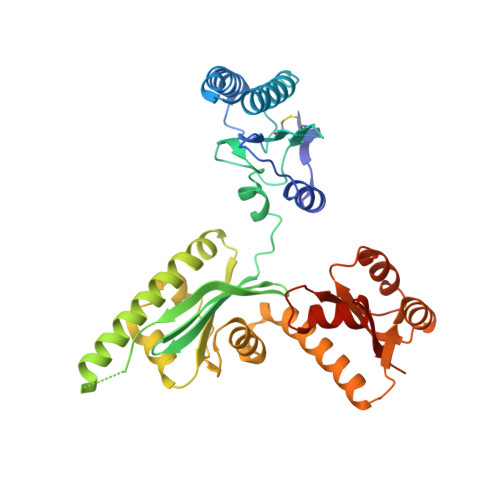Omnipotent role of archaeal elongation factor 1 alpha (EF1{alpha}) in translational elongation and termination, and quality control of protein synthesis
Saito, K., Kobayashi, K., Wada, M., Kikuno, I., Takusagawa, A., Mochizuki, M., Uchiumi, T., Ishitani, R., Nureki, O., Ito, K.(2010) Proc Natl Acad Sci U S A 107: 19242-19247
- PubMed: 20974926
- DOI: https://doi.org/10.1073/pnas.1009599107
- Primary Citation of Related Structures:
3AGK - PubMed Abstract:
The molecular mechanisms of translation termination and mRNA surveillance in archaea remain unclear. In eukaryotes, eRF3 and HBS1, which are homologous to the tRNA carrier GTPase EF1α, respectively bind eRF1 and Pelota to decipher stop codons or to facilitate mRNA surveillance. However, genome-wide searches of archaea have failed to detect any orthologs to both GTPases. Here, we report the crystal structure of aRF1 from an archaeon, Aeropyrum pernix, and present strong evidence that the authentic archaeal EF1α acts as a carrier GTPase for aRF1 and for aPelota. The binding interface residues between aRF1 and aEF1α predicted from aRF1·aEF1α·GTP ternary structure model were confirmed by in vivo functional assays. The aRF1/eRF1 structural domain with GGQ motif, which corresponds to the CCA arm of tRNA, contacts with all three structural domains of aEF1α showing striking tRNA mimicry of aRF1/eRF1 and its GTPase-mediated catalysis for stop codon decoding. The multiple binding capacity of archaeal EF1α explains the absence of GTPase orthologs for eRF3 and HBS1 in archaea species and suggests that universal molecular mechanisms underlie translational elongation and termination, and mRNA surveillance pathways.
Organizational Affiliation:
Division of Molecular Biology, Department of Basic Medical Science, Institute of Medical Science, University of Tokyo, 4-6-1 Shirokanedai, Minato-ku, Tokyo 108-8639, Japan.














